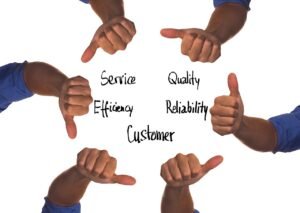
Understanding The RACE Model:
Customer Behavior Analysis provided a clear path to learning and understanding our buyer personas, the RACE framework provided an always-on marketing approach to ensure the brand is building an engaging relationship with its audience across 4 stages of the customer’s lifecycle (Chaffey, 2024). The four stages of the RACE model are Reach, ACT, Convert, and Engage where working with the customer along this journey allows them to have a clear understanding of the brand’s mission and how it benefits their needs. Whether in the B2B space or the B2C space employing the RACE methodology is key to a lasting relationship with the customer base. Learning the buyer persona that the brand service makes it easier to connect in the Reach and Act phase of the RACE model. Understanding the buyer personas allows the brand to connect and engage with the customer where it is most convenient for them.
The Conversion part of the model happens when you are successful with the Reach which brings awareness to the brand and Act is where customers are engaging with the media that the brand is providing. Conversion could be different things depending on what the goal of the brand is for its customers; it could be anything from sales, leads, email signups, completing a form, etc. (Group, n.d.). Conversion gives the brand feedback on how effective the marketing message is and how well they know the needs of the customers based on their buyer personas. Brands are always tweaking their messages to be clear and concise to ensure that they are not wasting their customer’s time. There are ethical concerns to consider when engaging with customers which are Behavioral and Contextual targeting that keeps the brand top of mind and can affect the customer in different ways. Behavioral targeting follows the customer’s journey across the web as they conduct their daily duties regardless of the relation to the brand and Contextual targeting is based on relatable interest that the customer may come across that aligns with the brand goals.
The final piece of the RACE model is Engagement where brands seek to maintain a lasting relationship with their customers. Brands utilize a variety of instruments to keep their customers engaged throughout their lifecycle for instance promotions, loyalty programs, giveaways, customer appreciation events, and surveys to name a few. The goal is to show appreciation for the customers they do have and build awareness of the brand to prospective customers who share the same interests and would be a great fit for their product or service. This is also a way to generate feedback for the brand to know how the customers both established and new are responding to the engagement efforts.
Chaffey, D. (2024, February 8). Race Plan Framework. Retrieved from Smart Insights: https://www.smartinsights.com/wp-content/uploads/2022/11/Race-Planning-Framework.png
Group, S. D. (n.d.). SEO Digital Group. Retrieved from SEO Digital Group: https://seodigitalgroup.com/what-is-a-conversion/